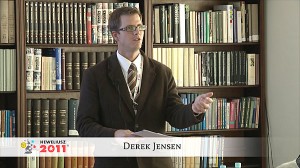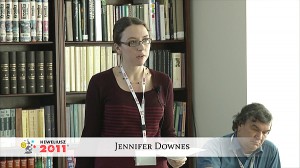Konferencja Hevelius 2011 – Sesja 4 – Patricia Radelet-de Grave
 Temat: Heweliusz, Kepler i komety.
Temat: Heweliusz, Kepler i komety.
Wykorzystanie na początku XVII wieku teleskopu w badaniach astronomicznych doprowadziło do odkrycia wielu nieregularności w świecie usytuowanym ponad Księżycem. Powierzchnię Księżyca pokrywały liczne góry i szczeliny, na Słońcu widoczne były plamy, a pośród gwiazd rozbłysła stella nova. Tego rodzaju obserwacje, jak również dyskusje prowadzone przez Orazzia Grassiego oraz Maria Guiducciego z udziałem Galileusza, Scipiona Chiaramontiego i Keplera na temat miejsca i trajektorii komet odegrały decydującą rolę w procesie odrzucania poglądów perypatetyckich. Kometarne koncepcje Keplera zgłębił Jan Heweliusz, a ustosunkował się do nich w swym dziele Comelographia (1668). Na frontyspisie traktatu wykonanym przez Andreasa Stecka i L. Visschera Heweliusz podkreśla wagę tych wcześniejszych dysput oraz przedstawia różnicę między swoją teorią a koncepcjami Keplera. W dyskusji przy stole biorą udział trzy osoby: obrońca poglądów perypatetyckich, Kepler i Heweliusz, prezentując własne zdanie. Komentarz dotyczący frontyspisu mówi nam bardzo dużo o kometarnych koncepcjach Heweliusza i pokazuje, jak istotny krok stanowiły ku teorii Newtona.
materiał w języku angielskim
Patricia Radelet-de Grave (Université catholique de Louvain):
Hevelius, Kepler and comets
At the beginning of XVII-th century, the use of telescopes contributed to the discovery of many irregularities in the celestial world situated above the Moon. The surface of the Moon itself was full of hills and gaps, there were spots on the Sun and a stella nova appeared among the fixed stars. Those observations as well as discussions, between Orazzio Grassi and Mario Guiducci with help of Galileo, Scipione Chiaramonti and Kepler, about position and trajectories of comets played a crucial role in the rejection of peripatetical ideas. Kepler’s ideas developed on that occasion were studied and discussed by Johannes Hevelius in his Cometographia that appeared 50 years later. In its frontispiece by Andreas Steck and L. Visscher, Hevelius underlines the importance of those previous discussions as well as the difference between his theory and Kepler’s one. Three persons are discussing around a table, a defender of peripatetical ideas, Kepler and Hevelius, each of them presenting his ideas on comets. Comments on this frontispiece will learn us much about Hevelius’s ideas on comets and on the considerable steps it marks in Newton’s direction.


